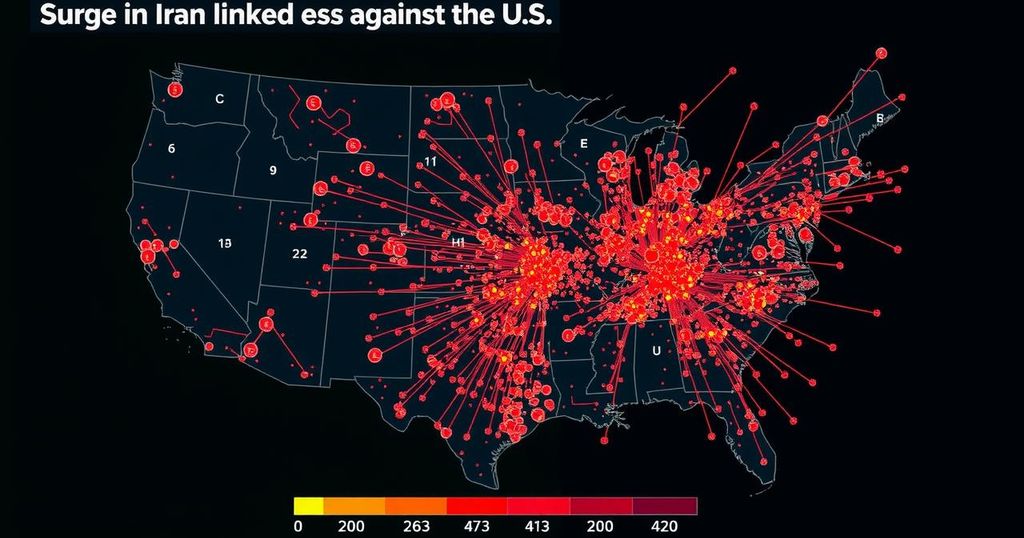Attacks on U.S. forces from Iran-linked groups have surged by 630% since the Hamas attack on Israel in October 2023. Following this incident, over 200 attacks involving rockets and drones have been launched at U.S. personnel in the region. The report reveals a strategic shift in targeting U.S. forces, suggesting a calculated approach by Iran to engage indirectly while avoiding direct retaliatory strikes against itself.
Attacks against U.S. interests by Iran-linked groups have surged by approximately 630% since the Hamas assault on Israel on October 7, 2023. This alarming increase, detailed in a report from the Jewish Institute for National Security of America (JINSA), highlights a rise in malign incidents, including cyber attacks, projectile strikes, and terrorist activities directed at U.S. personnel in Iraq and Syria. Following the conflict escalation between Israel and Hamas, Iranian-backed actors have intensified their assaults against U.S. forces, with a notable spike in missile and drone launches from locations in Iraq. Such actions appear to be a strategic attempt by Iran to leverage proxy engagements in the region without inviting direct retaliation against itself. The regional context of these attacks traces back to the U.S.’s withdrawal from the Iran nuclear deal in 2018, which fostered an environment of increased hostility. Under both preceding administrations, attacks against U.S. assets progressively mounted. Following the October escalation, Iran proxies significantly increased their acts of aggression, targeting not only Israel but also critical U.S. military interests. The current situation points to a complicated escalation of military engagement in Iraq and Syria, with possible global implications as terrorist groups continue to expand their operations. Reports from defense officials emphasized the operational security concerns that restrict detailed commentary on the specific number and impact of these threats. However, JINSA’s findings indicate a clear strategic pivot by Iranian proxies, as they increasingly favor targeting U.S. forces, which they perceive will provoke less military retaliation compared to attacks on Israel. The cumulative impact of these incidents showcases a disturbing trend of violence in the region, raising concerns about future confrontations between Iranian-linked groups and U.S. and allied forces. A projected increase in violence between Israel and Iranian militias could evolve into broader hostilities, further destabilizing an already volatile landscape. Major military actions are anticipated as stakeholders seek to either neutralize threats or respond to ongoing provocations. In light of these dynamics, assessing the ongoing implications of Iran-linked activities in the Middle East remains critical for U.S. and global security strategies, with the potential for heightened military engagement looming on the horizon.
Since the U.S. exited the Iran nuclear deal in 2018, there has been a notable escalation in aggressive actions by Iranian-affiliated groups, with a significant spike occurring following the October 2023 attack by Hamas on Israel. The regional landscape has become increasingly complex, as Iranian proxies aim to pressure U.S. interests while engaging in broader conflicts involving Israel, particularly amid ongoing conflicts in Gaza and Lebanon. The reality on the ground has become a battleground for indirect engagements between disparate forces, particularly as U.S. troops find themselves caught in escalating tensions without preemptive responses that significantly deter hostilities from Iranian factions.
The evident increase in Iranian-led hostilities against U.S. forces signals a precarious security environment in the Middle East, raising critical questions about the viability of existing military strategies and international diplomatic frameworks. With unmanned aerial vehicles and missile strikes now commonplace, the possibility of intensified violence, particularly with the role of Iranian proxies in Iraq and Syria, could fundamentally alter the operational landscape. This necessitates a thorough reassessment of U.S. engagements and the ramifications of Iranian aggression in the region to protect national interests and maintain regional stability.
Original Source: www.foxnews.com






